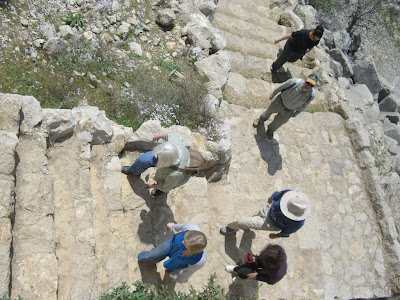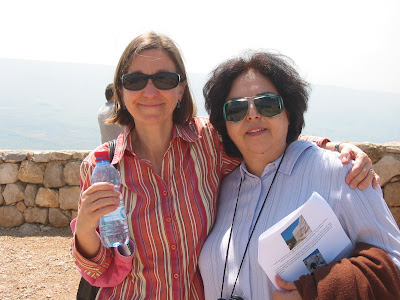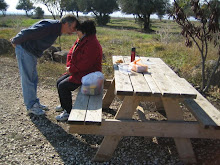 A special festival of Naw-Ruz (New Year) is held on 21 March each year and friends from the UK and the USA joined us this year for a lovely dinner.
A special festival of Naw-Ruz (New Year) is held on 21 March each year and friends from the UK and the USA joined us this year for a lovely dinner. Naw-Ruz also marks the end of a period of fasting. It is a Holy Day and we celebrated it in the beautiful Bahá’í gardens in Haifa with all the World Centre friends and hundreds of pilgrims. After the program we have the chance to catch up with dear friends
Naw-Ruz also marks the end of a period of fasting. It is a Holy Day and we celebrated it in the beautiful Bahá’í gardens in Haifa with all the World Centre friends and hundreds of pilgrims. After the program we have the chance to catch up with dear friends and to say good bye to others who are leaving soon.
and to say good bye to others who are leaving soon. A friend here invited those people who had made her first 2 months of service special to a “gratitude dinner”. After eating sumptuously, she personally thanked each one and spoke how some little act of kindness had meant so much to her. Here is Allan with Ann,
A friend here invited those people who had made her first 2 months of service special to a “gratitude dinner”. After eating sumptuously, she personally thanked each one and spoke how some little act of kindness had meant so much to her. Here is Allan with Ann,  one of the attendees, from the Caribbean.
one of the attendees, from the Caribbean. Spring is also the best time to see Israel’s national parks – right after the winter rain, which at 477mm was 88% of the annual average. Still, the countryside is so very lush and bursting with colour. So in early April we set off with some friends to explore the northern-most part of Israel.
Early spring is wildflower time in the Golan Heights—a place of exceptional beauty in Israel. We had not yet been to the most northern part of Israel near the border of both Syria and Lebanon. Mount Hermon (the source of the Jordan River) is found here and it is the only area in Israel
 where snow falls in winter—the ski fields are naturally very popular. Snow used to remain all year around; not these days. These two photographs of Mt. Hermon were taken 3 months apart, the latter one taken on our recent trip.
where snow falls in winter—the ski fields are naturally very popular. Snow used to remain all year around; not these days. These two photographs of Mt. Hermon were taken 3 months apart, the latter one taken on our recent trip. This map shows our journey - from Haifa to the southern section of Lake Kinneret (Sea of Galilee);
This map shows our journey - from Haifa to the southern section of Lake Kinneret (Sea of Galilee);  up the border of Israel with Jordan and Syria
up the border of Israel with Jordan and Syria to Nimrods Castle. In our January blog we showed photos of the Israel/Jordan/Syria border region and here we show just how special Nimrod Fortress is and also Banias—an amazing stream of melted snow straight from Mt. Hermon.
to Nimrods Castle. In our January blog we showed photos of the Israel/Jordan/Syria border region and here we show just how special Nimrod Fortress is and also Banias—an amazing stream of melted snow straight from Mt. Hermon.Known to the Arabs as Subebe and to the Crusaders as L'Asibebe, Nimrod's Fortress is the popular name by which one of Israel's largest Crusader fortresses is known.
 It is thought to have been built in the 13th century by Muslim armies
It is thought to have been built in the 13th century by Muslim armies  in order to defend themselves against the invading Crusader armies and to protect the pass.
in order to defend themselves against the invading Crusader armies and to protect the pass.
 Here are some examples of Arabic inscriptions found on site.
Here are some examples of Arabic inscriptions found on site.
 Conversely, others believe the fort was built by the Crusaders themselves in defence against the Muslims. It seems to have changed hands several times until subsequently the invading Mongols brought about the destruction of the fortress. Then the Mamelukes defeated the Mongols and reconstructed it to its great splendour. This is an example of motifs that can be found.
Conversely, others believe the fort was built by the Crusaders themselves in defence against the Muslims. It seems to have changed hands several times until subsequently the invading Mongols brought about the destruction of the fortress. Then the Mamelukes defeated the Mongols and reconstructed it to its great splendour. This is an example of motifs that can be found. The use of arches is mind boggling—ceilings more than 5m in height.
The use of arches is mind boggling—ceilings more than 5m in height. With the retreat of the Crusaders the importance of the fortress diminished. It served as a prison in the 15th century. Afterwards it was abandoned to the shepherds who wandered in that area.
With the retreat of the Crusaders the importance of the fortress diminished. It served as a prison in the 15th century. Afterwards it was abandoned to the shepherds who wandered in that area.  First the entrance to the fortress is impressive with large walls built with huge stones—it staggers the imagination as to how only human and animal labor could build such edifices.
First the entrance to the fortress is impressive with large walls built with huge stones—it staggers the imagination as to how only human and animal labor could build such edifices.  Inside the fortress, there are many rooms of various sizes, all fitted with those special windows that are wide on the outside and narrow on the inside. This permitted the defenders to see their attackers but keep themselves concealed.
Inside the fortress, there are many rooms of various sizes, all fitted with those special windows that are wide on the outside and narrow on the inside. This permitted the defenders to see their attackers but keep themselves concealed.  The front part of the fortress is divided into three floors
The front part of the fortress is divided into three floors  which can be accessed via a narrow winding staircase impressively built from individual stones.
which can be accessed via a narrow winding staircase impressively built from individual stones. Below the entrance level is a huge room that was the water reservoir.
Below the entrance level is a huge room that was the water reservoir.  It still has some of the original plaster on the walls, and from the look of the water in the reservoir, it is left over from the Middle Ages.
It still has some of the original plaster on the walls, and from the look of the water in the reservoir, it is left over from the Middle Ages. 
The fortress is divided into three areas

and has different architectural styles of the builders from different times.



The front is lower and seems to be the more fortified area of the fortress. The middle is not as well excavated. The walls defending the central area had several massive turrets that in turn had several rooms to them.
Here is a round turret reminiscent of the castles in Europe.
 The rear part seemed to have been the administrative part of the fortress. It has the remains of a moat intended to protect it from attackers (not very effectively!!).
The rear part seemed to have been the administrative part of the fortress. It has the remains of a moat intended to protect it from attackers (not very effectively!!). 
 This section is not yet fully excavated, but from the top a breath-taking view of the front section of the fortress with the Hula Valley behind can be seen.
This section is not yet fully excavated, but from the top a breath-taking view of the front section of the fortress with the Hula Valley behind can be seen. After a wonderful lunch,
After a wonderful lunch, 

 we made the short drive to Banias springs, which begin at the foot of Mount Hermon. Waters rush with great force through a canyon-like channel,
we made the short drive to Banias springs, which begin at the foot of Mount Hermon. Waters rush with great force through a canyon-like channel,  losing 190 meters in altitude over the course of three and a half kilometers, eventually forming the Banias waterfall,
losing 190 meters in altitude over the course of three and a half kilometers, eventually forming the Banias waterfall, 
one of the most beautiful in Israel. After nine kilometers, the Hermon River meets the Dan River and the jointly into the Jordan River.
A wide staircase connects the Banias spring to the Banias cave. Long ago, the spring actually bubbled from within the cave.
 The five grottos in the nearby cliff are remnants of a shrine to the god Pan, the origin of the name Panias (or Banias, as it was pronounced in Arabic). A short path leads from the cave to a white structure atop a step on the cliff, which is the graveside of the Druze Saint, Nebe Hader. Outside the cave are the remains of a temple built by Herod.
The five grottos in the nearby cliff are remnants of a shrine to the god Pan, the origin of the name Panias (or Banias, as it was pronounced in Arabic). A short path leads from the cave to a white structure atop a step on the cliff, which is the graveside of the Druze Saint, Nebe Hader. Outside the cave are the remains of a temple built by Herod. The path along the stream  leads to the waterfall
leads to the waterfall  As it was early spring the water flowed strongly and this sound in a desert country is simply amazing. The cool humidity reminds one of being in a rainforest.
As it was early spring the water flowed strongly and this sound in a desert country is simply amazing. The cool humidity reminds one of being in a rainforest.
Our next post will show some of the amazing wildflowers of the Golan Heights with photos of recent visitors...
 leads to the waterfall
leads to the waterfall  As it was early spring the water flowed strongly and this sound in a desert country is simply amazing. The cool humidity reminds one of being in a rainforest.
As it was early spring the water flowed strongly and this sound in a desert country is simply amazing. The cool humidity reminds one of being in a rainforest.Our next post will show some of the amazing wildflowers of the Golan Heights with photos of recent visitors...



No comments:
Post a Comment